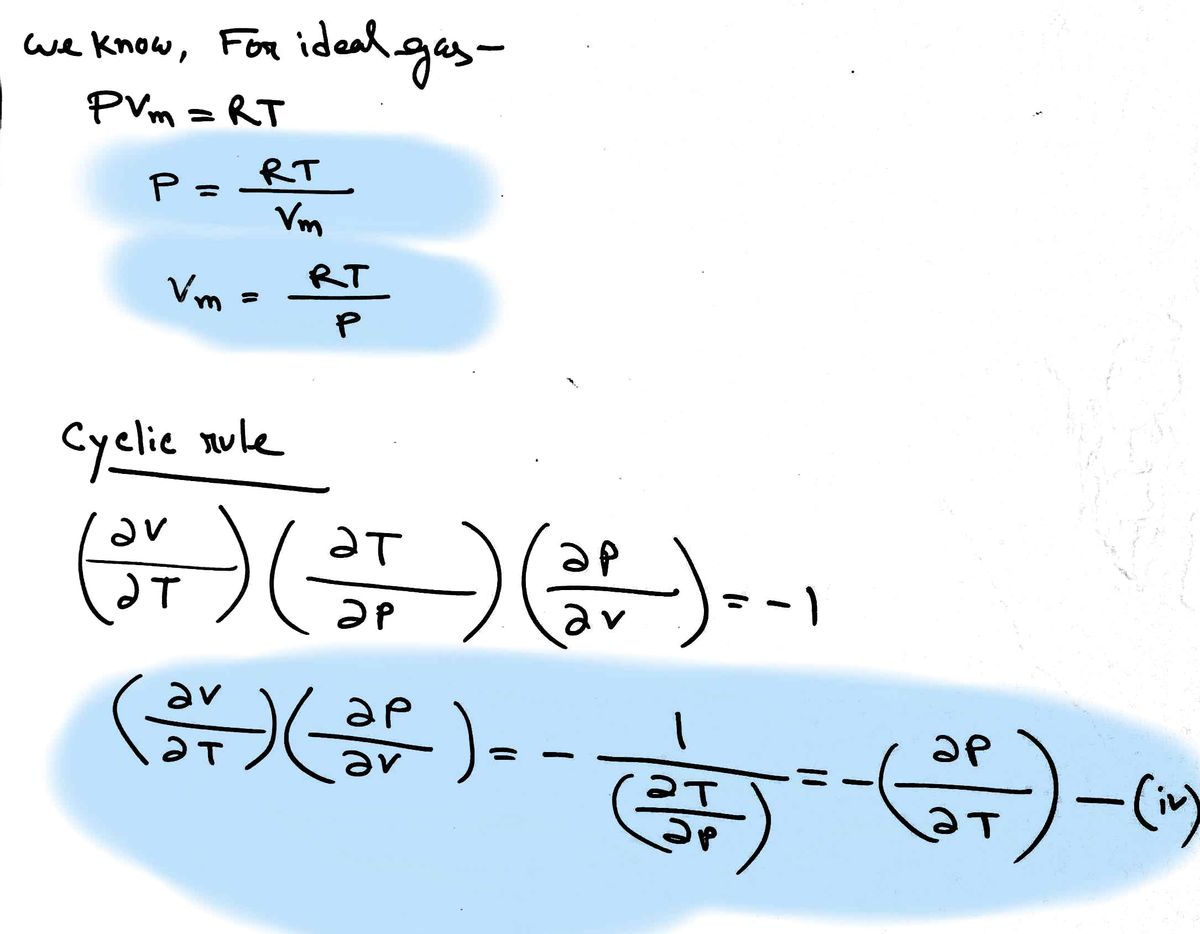We know that for an ideal gas Cp,m = Cv,m + R. %3D The general relationship for any gas can be written, for 1 mole, as Cp,m = Cy,m + (Yn") a²VmT` k (equation-1) Where Vm is the molar volume (the volume of 1 mole of the gas, V/n). a is the coefficient of volume expansion and is given by: a = where the partial derivative of V with respect to T is calculated ƏT assuming P is constant And K is the coefficient of volume expansion and is given by: k = GO where the partial derivative of V with respect to P is calculated assuming T is constant. Note the minus in the definition. Prove that equation-1 reduces to the result derived in class for an ideal gas by calculating (A²V¼T\ k
We know that for an ideal gas Cp,m = Cv,m + R. %3D The general relationship for any gas can be written, for 1 mole, as Cp,m = Cy,m + (Yn") a²VmT` k (equation-1) Where Vm is the molar volume (the volume of 1 mole of the gas, V/n). a is the coefficient of volume expansion and is given by: a = where the partial derivative of V with respect to T is calculated ƏT assuming P is constant And K is the coefficient of volume expansion and is given by: k = GO where the partial derivative of V with respect to P is calculated assuming T is constant. Note the minus in the definition. Prove that equation-1 reduces to the result derived in class for an ideal gas by calculating (A²V¼T\ k
Chemistry
10th Edition
ISBN:9781305957404
Author:Steven S. Zumdahl, Susan A. Zumdahl, Donald J. DeCoste
Publisher:Steven S. Zumdahl, Susan A. Zumdahl, Donald J. DeCoste
Chapter1: Chemical Foundations
Section: Chapter Questions
Problem 1RQ: Define and explain the differences between the following terms. a. law and theory b. theory and...
Related questions
Question

Transcribed Image Text:We know that for an ideal gas Cp,m = Cv,m + R.
%3D
The general relationship for any gas can be written, for 1 mole, as
Cp,m = Cy,m +
(Yn")
a²VmT`
k
(equation-1)
Where Vm is the molar volume (the volume of 1 mole of the gas, V/n).
a is the coefficient of volume expansion and is given by:
a =
where the partial derivative of V with respect to T is calculated
ƏT
assuming P is constant
And K is the coefficient of volume expansion and is given by:
k =
GO where the partial derivative of V with respect to P is calculated
assuming T is constant. Note the minus in the definition.
Prove that equation-1 reduces to the result derived in class for an ideal gas by calculating
(A²V¼T\
k
Expert Solution
Step 1

Trending now
This is a popular solution!
Step by step
Solved in 3 steps with 2 images

Knowledge Booster
Learn more about
Need a deep-dive on the concept behind this application? Look no further. Learn more about this topic, chemistry and related others by exploring similar questions and additional content below.Recommended textbooks for you

Chemistry
Chemistry
ISBN:
9781305957404
Author:
Steven S. Zumdahl, Susan A. Zumdahl, Donald J. DeCoste
Publisher:
Cengage Learning

Chemistry
Chemistry
ISBN:
9781259911156
Author:
Raymond Chang Dr., Jason Overby Professor
Publisher:
McGraw-Hill Education

Principles of Instrumental Analysis
Chemistry
ISBN:
9781305577213
Author:
Douglas A. Skoog, F. James Holler, Stanley R. Crouch
Publisher:
Cengage Learning

Chemistry
Chemistry
ISBN:
9781305957404
Author:
Steven S. Zumdahl, Susan A. Zumdahl, Donald J. DeCoste
Publisher:
Cengage Learning

Chemistry
Chemistry
ISBN:
9781259911156
Author:
Raymond Chang Dr., Jason Overby Professor
Publisher:
McGraw-Hill Education

Principles of Instrumental Analysis
Chemistry
ISBN:
9781305577213
Author:
Douglas A. Skoog, F. James Holler, Stanley R. Crouch
Publisher:
Cengage Learning

Organic Chemistry
Chemistry
ISBN:
9780078021558
Author:
Janice Gorzynski Smith Dr.
Publisher:
McGraw-Hill Education

Chemistry: Principles and Reactions
Chemistry
ISBN:
9781305079373
Author:
William L. Masterton, Cecile N. Hurley
Publisher:
Cengage Learning

Elementary Principles of Chemical Processes, Bind…
Chemistry
ISBN:
9781118431221
Author:
Richard M. Felder, Ronald W. Rousseau, Lisa G. Bullard
Publisher:
WILEY